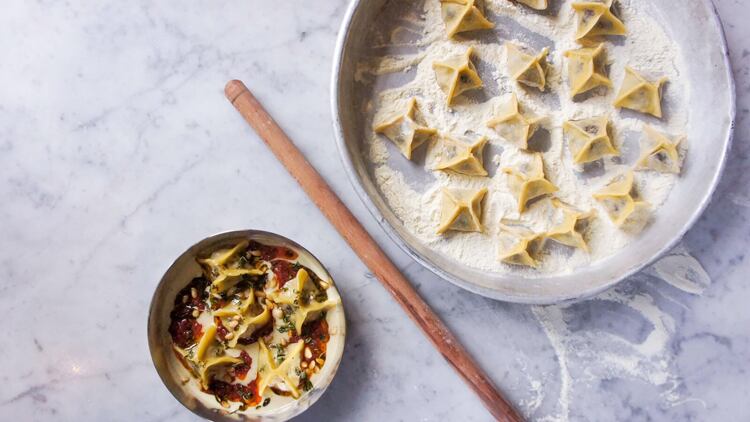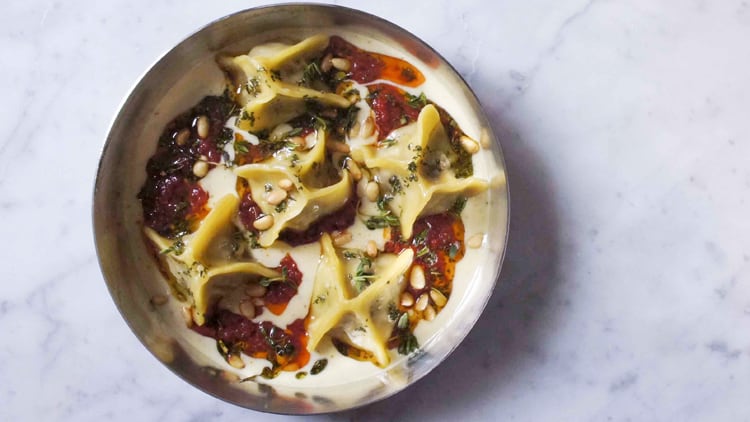Kyseri, chef Selin Kiazim’s Fitzrovia restaurant, takes its name from the city of Kayseri, in Anatolia, Turkey. The city is renowned for one dish in particular: Kayseri manti, tiny meat-filled dumplings, boiled and served with yoghurt, melted butter and Aleppo chilli flakes. Tradition holds that, when a bride is to be married, her prospective mother-in-law will visit her house and judge her skill at making manti. The smaller the better: ideally, 40 per spoonful.
While faithful to the flavour of the dish, you would need a very large spoon to accommodate 40 of Kiazim’s manti. Made from 6cm squares of pasta, the corners drawn in to the middle to seal in the filling, they are substantial dumplings, with a higher ratio of filling to pasta than is possible with the miniature version: sauced both with a rich, buttery, tomato and chilli sauce and a yoghurt sauce that is two-thirds double cream, four of her manti makes for a generous portion, and they have become the dish for which Kyseri is best known.
Kiazim stresses that the filling, which incorporates semi-dried sour cherries (available online from www.theturkishshop.com or from Middle Eastern groceries) is the most crucial part of the dish. “The mix should tighten as you work the protein, and there should be a sheen of fat on your hands when the filling is ready,” she says. “We use beef from Philip Warren, in Launceston, Cornwall, and we ask for 10% fat content, so that the meat won’t dry out when it cooks.”
She makes her pasta with inci flour imported from Turkey but 00 grade pasta flour is fine, too. “I’ve gone a bit off-piste with the sour cherries and the toasted fennel seeds, but I really wanted to keep the authentic bite to the dumplings,” she says. To which end, rather than squeezing the joins in the pasta hard, as you might with tortelloni to maintain an even thickness, Kaizim likes to keep a double thickness of pasta at the seams.
Manti are part of a huge family of dumplings, a hallmark of Turkish cuisines stretching from China through Afghanistan (where they are known as mantu, and also dressed with yoghurt and tomato) and central Asia to Armenia, Bosnia, Turkey and northern Cyprus, from where Kiazim’s family hails. “My mother calls them pirohu: they are quite similar in construction, but stuffed with cheese and flavoured with dried mint, with lots of halloumi grated over the top. But no spice. Cypriots use much less spice than Anatolians.”

Shapes and cooking techniques for this extended family of dumplings also vary from culture to culture. “Some are shaped like sweet wrappers, then parboiled and fried.” Others might be steamed, rather than boiled, and there is a clear overlap with the momos, potsticker dumplings and gyoza that belong respectively to Nepalese, Chinese and Japanese cuisines.
There is something quintessentially Anatolian, however, about the saucing: chilli flakes add a slightly smoky heat, while tatli biber salçasi, a mild paste of reduced red peppers and salt (available www.souschef.co.uk), adds a rich sweetness. Kiazim sharpens the sauce with sherry vinegar and adds texture and aroma with toasted pine nuts and fresh thyme.
The finished manti have both complexity and integrity. Mothers-in-law would have to be especially hard hearted not to appreciate them. And, after all, size isn’t everything.
Beef and sour cherry manti with yoghurt sauce and tomato-chilli butter
To serve four
Ingredients:
For the manti filling:
500g beef mince (10% fat)
120g Spanish onion, finely minced
80g flat leaf parsley, as finely chopped as possible
80g sour cherries, coarsely chopped
1½ tsp fennel seeds, lightly toasted and ground
9g table salt
For the pasta:
300g pasta flour
1 whole egg, beaten
60ml water
2 tbsp olive oil
5g salt
Semolina, for dusting
For the yoghurt sauce:
2 tbsp extra virgin olive oil
2 banana shallots, diced
2 cloves garlic, microplaned
1½g picked thyme leaves
50ml dry white wine
330ml double cream
170ml full fat Greek yoghurt
For the tomato-chilli butter:
500g passata
250g unsalted butter
3 tbsp tomato purée
1 tbsp mild pepper paste
1 clove of garlic, crushed
Pinch of dried oregano
1 tbsp pul biber (Turkish chilli flakes)
8g sherry vinegar
5g caster sugar
7g table salt
To serve:
50g toasted pine nuts
1 tbsp picked fresh thyme leaves
Method:
1. Combine all the ingredients for the manti filling and mix extremely well by hand until smooth. Fry or microwave a small amount to check the seasoning, adjusting if necessary.
2. To make the pasta, mix the flour with the salt, then make a well in the middle and add the egg, the olive oil and most of the water. Bring together into a ball, adding more water if necessary, and knead for 10 minutes or so until smooth, then put the dough twice through a pasta machine set to 2.5: the sheets of pasta should be the thickness of a 2p piece.
3. Dust a work surface with semolina, then cut the pasta into 6cm squares. Roll the filling into 30g balls and put one in the middle of each square. Brush the edges lightly with water, then bring the four corners to the middle to seal in the filling, being careful not to press too hard or to leave air pockets in the manti. Put the manti on a tray dusted with more semolina and let them dry naturally.
4. To make the yoghurt sauce, cook the shallots in the olive oil until deep golden brown. Add the garlic and thyme and cook for 2 minutes. Add the wine and reduce by half, then add the cream and cook for another 8 minutes, making sure it does not catch on the bottom of the pan. Remove from the heat, whisk in the yoghurt, then liquidise and season to taste with salt.
5. For the tomato-chilli butter, foam 160g of the butter in a tall pan, then add the oregano and the tomato purée. Cook, stirring, over a medium heat for 2 minutes, then add the passata, a pinch of salt and the pepper paste. Cook very gently without a lid until the sauce is reduced by two thirds. Finish with the vinegar, sugar and salt.
6. While the sauce reduces, melt the remaining butter and cook until nut brown. Add the pul biber and cool slightly, then add the garlic and let it rest for 20 minutes. Combine with the tomato sauce.
7. To serve, cook the manti in plenty of boiling, salted water for 4½ minutes. Drain, then divide the manti between bowls, top generously with both sauces, and then sprinkle with the toasted pine nuts and fresh thyme leaves.
This is a web version of an article that first appeared in the October issue of Restaurant magazine, the leading title for the UK's restaurant industry. For more features, comment, interviews and in-depth analysis of the restaurant sector subscribe to Restaurant magazine here.

